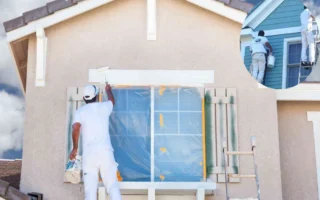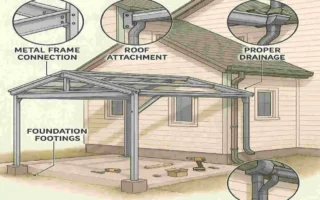Imagine stepping out into your backyard on a sunny afternoon, where a beautiful structure shades your patio just right. That’s the magic of a pergola. These open-air frameworks, often made from wood or metal with lattice tops, have become a hit in modern outdoor living. Homeowners love them for adding style and a touch of relaxation to their spaces. But here’s the big question: should a pergola be attached to a house? It’s not just about looks—it’s about making a choice that fits your lifestyle, home, and budget.
Many people debate whether to attach a pergola directly to their home or let it stand alone. Attaching it can create a seamless extension of your indoor space, perfect for barbecues or quiet evenings. On the other hand, a standalone version offers more flexibility in placement. Getting this decision right is crucial because a poor choice could lead to structural issues, additional costs, or even regrets down the line. It enhances your home’s beauty, boosts functionality, and ensures everything holds up over time.
Pergolas trace their roots back to ancient times, used in gardens for shade and vine growth. Today, they’re popping up everywhere, from suburban backyards to urban rooftops. Their popularity stems from the trend toward outdoor living rooms—spaces where you can dine, relax, or entertain without fully committing to a closed structure like a gazebo. If you’re pondering whether a pergola should be attached to a house, you’re not alone. A quick search shows thousands of homeowners wrestling with this.
What Is an Attached Pergola vs. a Freestanding Pergola?

Let’s start with the basics. An attached pergola connects directly to your house, usually to an exterior wall or roofline. It acts like an extension, sharing support from your home’s structure. Picture it hugging the side of your home, creating a shaded walkway or lounge area right off your back door.
In contrast, a freestanding pergola stands on its own, supported by posts anchored into the ground. It doesn’t touch your house at all, so that you can place it anywhere in your yard—like over a garden path or near a pool. This independence makes it feel like a separate oasis.
Visually, attached versions blend seamlessly with your home’s design, often matching siding or roof styles for a unified look. Freestanding ones can be more artistic, with unique shapes or heights that don’t have to align with your house. Functionally, attached pergolas extend your living space outdoors, making transitions from kitchen to patio effortless. Freestanding ones offer privacy or zoning, like sectioning off a quiet reading nook away from the main house.
Think about typical uses. Attached pergolas shine in small yards where space is tight; they’re great for covering decks or patios without eating up extra room. Freestanding ones suit larger properties, perhaps framing a hot tub or fire pit. Understanding these differences is crucial before you ask yourself: Should a pergola be attached to a house? It sets the stage for weighing benefits against your needs.
Why does this matter? Choosing wrong could mean a structure that feels out of place or requires costly fixes. For example, if your yard is sloped, a freestanding option might handle uneven ground better. Attached ones rely on your home’s flat foundation.
Take a moment: Look at your home. Does it have a suitable wall for attachment? Or do you prefer something movable? These questions highlight why knowing the types helps.
Benefits of Attaching a Pergola to Your House
Attaching a pergola to your house comes with some fantastic perks. Let’s talk about space-saving first. By connecting it to your home’s wall, you make the most of limited yard space. No need for extra posts or foundations on that side—it borrows from your house. This is a game-changer for cozy backyards where every inch counts.
It also integrates smoothly with existing outdoor spots like patios or decks. Imagine walking straight from your living room onto a shaded area. It creates that effortless flow, turning your backyard into an extension of your home. Guests love it for gatherings, as it feels like one big space.
Shade is another big win. An attached modern pergola extends partial cover right from your house, blocking harsh sun without fully enclosing the area. You can grow climbing plants for natural dappled light, making it ideal for hot afternoons. This setup enhances your outdoor flow, blending seamlessly indoors and out.
What about property value? A well-integrated attached pergola boosts curb appeal. Potential buyers see it as a thoughtful addition, potentially increasing your home’s worth. It’s like adding a stylish outdoor room without major renovations.
Structurally, it’s more stable. Tying into your house’s frame means it withstands wind better than a standalone version. No worries about it shifting in storms—it’s anchored solidly.
And let’s not forget the indoor-outdoor living vibe. It encourages more time outside, whether grilling or relaxing. Families find it perfect for creating memories in a shaded, connected space.
Cost-wise, attached pergolas often save money. You skip the complete foundation work since it shares the same base as your home. Materials and labor drop, making it budget-friendly compared to freestanding options that need complete support systems.
Consider this: If you’re into the benefits of an attached pergola, think about how it could transform your daily routine. Have you pictured lounging under one attached to your home?
To sum up some key advantages in a quick list:
- Space efficiency: Maximizes small areas.
- Seamless integration: Blends with patios and decks.
- Enhanced value: Boosts home appeal and resale.
- Cost savings: Reduces build expenses.
Overall, if a pergola attached to a house that fits your vision, these benefits make a strong case.
Drawbacks and Challenges of Attaching a Pergola
Of course, no choice is perfect. Attaching a pergola can lead to wear on your home’s exterior. Drilling into walls might cause cracks or damage over time, especially if not done right. Think about how the weather could accelerate this—rain seeping in could harm siding.
Permitting is another hurdle. Many areas have strict building codes for attachments. You may need approvals to ensure it doesn’t violate rules, which can add time and paperwork. Failing to comply could result in fines or forced removal.
Placement gets limited too. You’re stuck with your house’s layout—no moving it later if you rearrange the yard. If your architecture has odd angles or low eaves, it might not fit well.
Repairs can be a nightmare. If something breaks, accessing attached parts means dealing with your home’s structure. Replacing beams could involve opening walls, turning a simple fix into a big project.
Moisture issues pop up often. Poor drainage might lead to water pooling against your house, causing rot or leaks. Gutters and roofing get impacted—attachments could redirect water poorly, leading to costly fixes.
Siding, such as vinyl or stucco, may not be well-suited to handle the weight or hardware. It could warp or fade where it is connected, affecting the look of your home.
Design flexibility suffers compared to freestanding pergolas. You can’t experiment with shapes as freely since they must match your house.
Let’s break down some common challenges in a table for clarity:
Challenge Description: Potential Fix
Wall Damage Attachment hardware can wear on exterior materials. Use protective seals and professional installation.
Permitting Restrictions: Local codes may limit attachments. Check with authorities early.
Limited Placement Constrained by house layout. Plan around architecture from the start.
Moisture Problems, Risk of leaks and rot. Install proper drainage systems
Repair Difficulties: Hard to access without house involvement. Opt for durable materials
These drawbacks remind you to weigh whether a pergola attached to a house aligns with your setup. Have you considered how your home’s materials might react?
In short, while attached pergolas offer perks, these challenges require careful thought to avoid headaches.
Factors to Consider When Deciding: Should a Pergola Be Attached to a House?

Deciding whether a pergola should be attached to the house involves several key factors. Let’s break them down one by one to help you think through it. We’ll cover everything from your home’s build to your budget, making sure you have a clear picture.
Home Architecture and Exterior Material
Your house’s design plays a huge role. Start by checking if the wall you want to attach to is sturdy enough. Brick or stucco walls handle attachments well—they’re durable and provide solid anchoring points.
Vinyl or wood siding? That’s trickier. These materials might not support heavy loads without reinforcement. You may need to access the framing behind them for a secure fit.
Consider the overall architecture. A modern home with flat roofs might integrate an attached pergola beautifully, while a sloped-roof Victorian could clash. Ask yourself: Does this enhance my home’s style or stick out awkwardly?
Structural integrity matters too. Older homes might have weakened walls, risking collapse if you add weight. Get a pro to inspect—better safe than sorry.
Intended Use and Functionality
What do you plan to do under your pergola? If it’s for shade over a patio, attaching makes sense—it extends your space naturally.
For complete coverage, such as rain protection, you might add fabric or roofing, but these attachments limit options. Think about flow: Attached ones create smooth transitions for entertaining, linking the kitchen to the yard.
If it’s near a pool or for parties, functionality shifts. Attached versions integrate with decks, but ensure the design supports furniture or grills without crowding.
Engage with this: Picture your ideal setup. Does attaching fit your daily use, like morning coffee or evening dinners?
Local Climate and Weather Impact
The weather can make or break your choice. In windy areas, attached pergolas gain stability from the house, resisting gusts better.
But storms bring risks—high winds could stress the attachment, damaging your wall. Sun exposure counts too: South-facing yards get intense light, so orientation matters for shade.
Rainy climates? Ensure good drainage to avoid water damage. Hot, dry spots might favor attachments for easy vine growth and cooling.
Consider your location: How does your weather influence whether a pergola should be attached to the house?
Budget and Construction Costs
Money talks. Attached pergolas often cost less since they share your home’s foundation, cutting material needs.
Compare: Freestanding ones might run $5,000–$15,000 with full posts and bases, while attached ones could be $3,000–$10,000. Labor varies—attachments require skilled work on your house.
Factor in long-term savings: Less foundation work means quicker builds. However, if permits incur additional fees, budgets shift.
Weigh this: What’s your spending limit? Could savings from attaching free up cash for upgrades?
Building Codes, Permits, and HOA Rules
Don’t skip the rules. Local authorities often require permits for attachments to ensure safety.
HOAs might ban them if they alter the appearance of your home. Check early to avoid denials.
These regs protect you— they prevent unsafe builds. Consult pros for compliance.
Maintenance and Longevity
Attached pergolas can be easier to maintain since they’re accessible from home, but risks to your house exist, like paint touch-ups where connected.
Longevity depends on materials: Treated wood lasts in attachments, resisting rot from house moisture.
Think ahead: How much upkeep are you willing to do? This ties back to the pros and cons of an attached pergola.
In a bullet list of tips:
- Assess your wall’s strength before deciding.
- Match materials to your climate for durability.
- Budget for permits to stay legal.
By considering these, you’ll be able to confidently answer whether a pergola should be attached to a house.
How to Properly Attach a Pergola to Your House: Step-by-Step Guide
Ready to attach? Let’s walk through it step by step. This guide assumes you’re going for it after weighing whether a pergola should be attached to the house. Always prioritize safety.
First, plan and measure. Sketch your design, noting wall height and width. Measure twice—ensure the pergola fits without overhanging oddly.
Choose materials wisely. Use galvanized hardware to resist rust; ledger boards attach to your house for the base.
For drainage, slope the top slightly away from your home. Seal all joints with caulk to prevent leaks—water is your enemy here.
Attach to framing, not just siding. Locate studs with a finder, then secure with lag bolts for strength.
Safety first: Wear gear and use stable ladders. Hire a contractor if unsure— they know pergola attachment tips.
Avoid mistakes like ignoring codes or poor sealing, which lead to damage.
Step by step:
- Plan layout and get permits.
- Gather tools and materials.
- Mark and attach the ledger to the framing.
- Build posts and beams.
- Seal and test stability.
Follow this, and your attached pergola will thrive.
Alternatives to Attaching a Pergola
Not sold on attaching? Freestanding pergolas offer freedom. Place them anywhere, enjoying benefits like easy relocation and no house damage.
They provide unique perks, such as creating focal points in large yards. Add lights or curtains for a cozy vibe.
Portable options, like foldable frames, suit renters—quick setup without permanence.
Retractable pergolas adjust for weather, extending or folding as needed.
Pergola kits make DIY projects easy, with modular designs that allow for customization.
Combine with awnings for extra shade or gazebos for enclosure. These alternatives expand your options beyond simply asking whether a pergola should be attached to the house.




